
FOR this FNY Crosstown post I selected 4th Street, which is the only numbered east-west street (that always had a number) to almost go river to river south of 13th Street. I say “almost” since West 4th stops short of the Hudson by about 4 blocks, and East 4th is stopped by the Jacob Riis Houses at Avenue D from proceeding on to the East River.
4th Street didn’t always used to be nearly all the way crosstown. The portion west of 6th Avenue that runs through Greenwich Village used to be called Asylum Street. West 4th turns northwest at 6th Avenue and intersects 10th, 11th, 12th and 13th. The short story is that in the early 19th Century the Orphan Asylum Society stood on the street between Bank and Troy (12th) and the street that went past it was called called Asylum Street, and when the asylum was torn down in 1833, the city decided to make it a western extension of West 4th, creating illogical intersections when the other named streets also acquired numbers. Asylum Street had been previously renamed in 1813 from William Street, possibly to avoid redundancy with the William Street downtown.
Bob Dylan’s 1965 putdown hit, “Positively 4th Street” came out the same year as his LP named for another route, “Highway 61 Revisited.” It has never been “positively” cleared up, by Bob himself or anyone else, what 4th Street is in the title. It could be this 4th Street or it could be the one in Minneapolis, where he also spent a chunk of time.
To save myself time and sanity, I’ll have to split up my coverage of 4th Street into several posts, 2 or 3, probably. I’ll confine myself today to the section that runs through the Village up to 6th Avenue, the former Asylum Street.
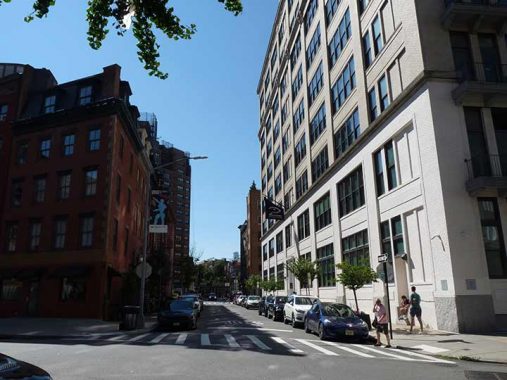
This is the northern end of West 4th as seen from West 13th at Gansevoort. Though traffic runs north here, like the rest of West 4th west of 6th Avenue, it’s cut off from the bulk of the rest of the street by the very wide 8th Avenue.
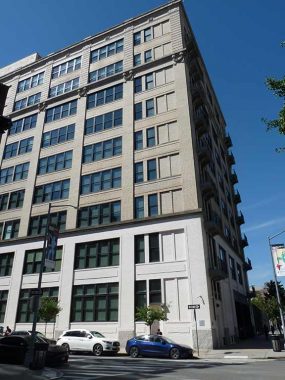
This massive 9-story loft building facing West 4th between Gansevoort and Horatio was constructed in 1912 as #342-356 West 4th, but when it was converted to luxury apartments, it was given a new address, #2 Gansevoort.
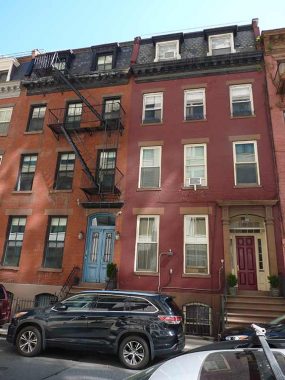
#347 and 345 West 4th, part of a row was built in 1868 for Matthew Kane, a neighborhood sashmaker, according to the Greenwich Village Landmarks Designation Report. In the 1860s, “sashmakers” made window sashes and other building materials.
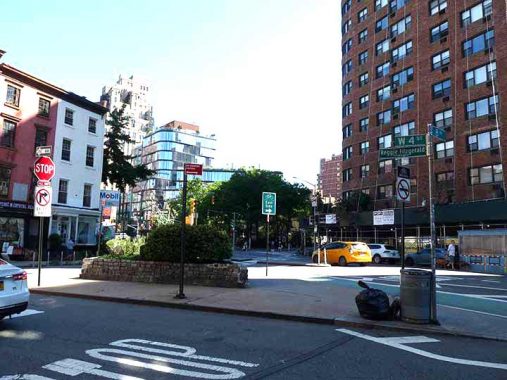
The triangle between West 4th, Horatio Street and 8th avenue is called Reggie Fitzgerald Triangle:
Reggie Fitzgerald (1929-1995) was a community leader in Greenwich Village. The owner of clothing store on West 4th Street, he was a longtime member and officer of the Horatio Street Association. He helped organize residents into night patrols in cooperation with the 6th Precinct. Also active in Community Board 2, he served on its Gay and Lesbian Committee, chaired its Traffic and Transportation Committee, and was an advocate for historic preservation. [oldstreets]
The glassy, undulating One Jackson Square at 8th and Greenwich Avenues can be seen in the rear of the photo.
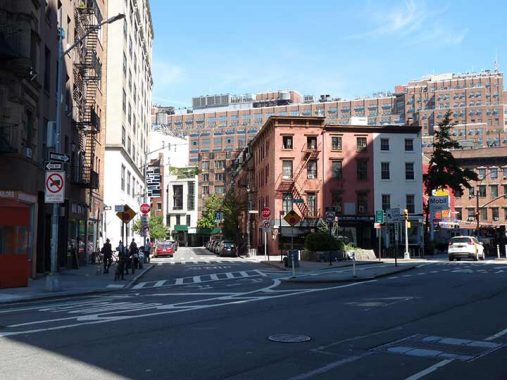
Greenwich Village has a number of surprising intersections because both 7th Avenue (South) and 8th Avenue incur on its generally NW-SE grid. Here, we see West 4th on the left, the houses on Horatio Street center right, and 8th Avenue on the right.
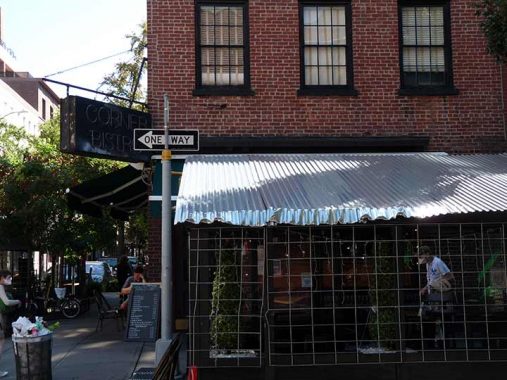
Corner Bistro, at Jane Street and West 4th with a classic neon sign and for now, Covid Pandemic outdoor dining shed. Though a tavern has been in the building since the late 1880s, masquerading as a butcher shop during Prohibition, the restaurant was founded in the 1960s, and has survived because management owns the building. It was the subject of a 1977 New York Times rave review for its burger, still considered among the city’s best. The restaurant gained a new location in Long Island City in 2012; the Pandemic forced its closure in 2020. Prices have been kept down with the classic Bistro Burger checking in at $12.75. A 1940 photo shows that the mast for the neon sign has been there for many years.
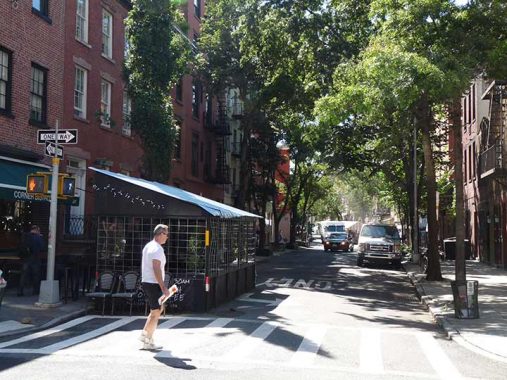
Looking south on West 4th from Jane Street, early September 2021.
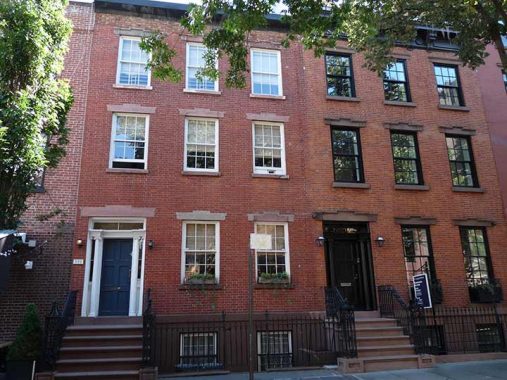
#329 and 331 West 4th Street between Jane and West 12th were Federal houses constructed in 1829 for David Bogart, a cartman (A person who transports goods or people by horse and cart and can also be a private garbage collection and haulage worker or contractor.)

#314 West 4th, or #284 West 12th, just appears to be an Art Moderne building. Its current brick facing and casement windows were installed in 1927 but it was actually built in 1845! Cafe Cluny, the moderately pricy bistro on the corner, shares ownership with the more famed Odeon on west Broadway.
Note not one but two Covid Pandemic sheds. West 12th still boasts its Belgian block paving from years gone by.
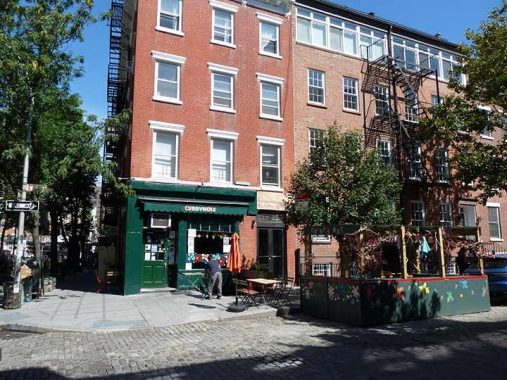
The corner building, #281 West 12th, was built in 1870, but #279 and 277 next door go back to 1830 and were originally 2 1/2 stories high.
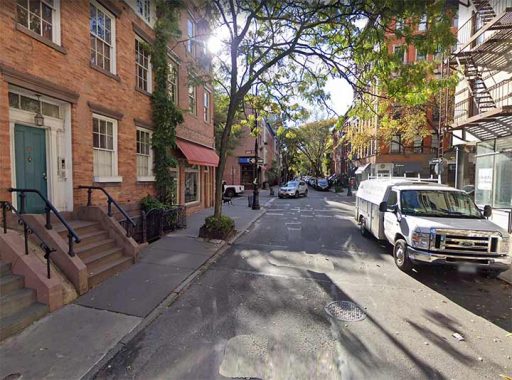
A classic: West 4th between West 12th and Bank puts “The Village” in The Village.
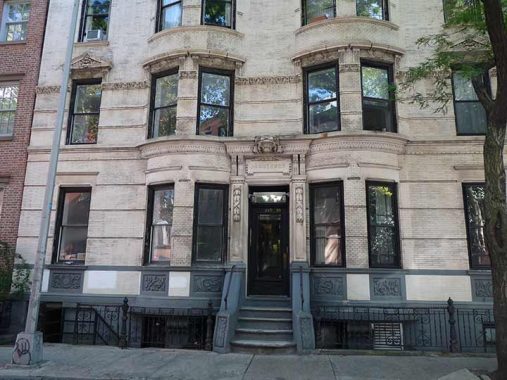
#287-289 West 4th, north of West 11th, has its address carven above the front door. The five story apartment building opened in 1906.
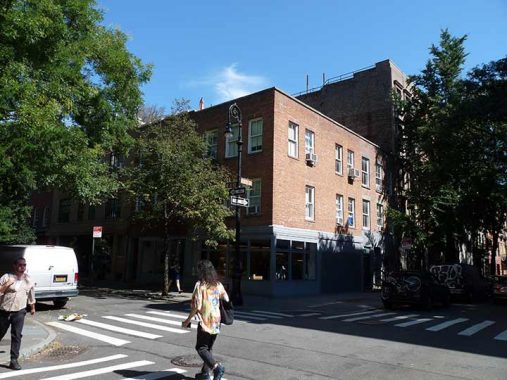
#49 Perry Street, on the corner of West 4th, has a modern facade that hides its true age: it was built in 1828.
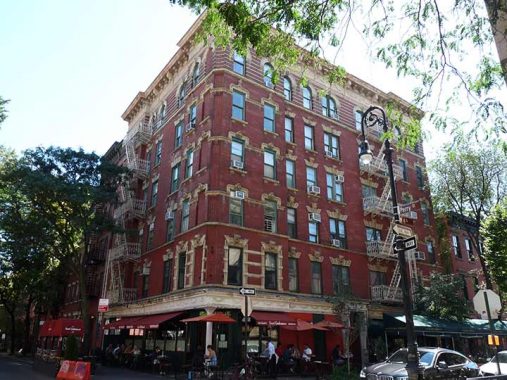
A magnificent apartment house, “the Victoria” at #259 West 4th, a.k.a. #52 Perry Street.
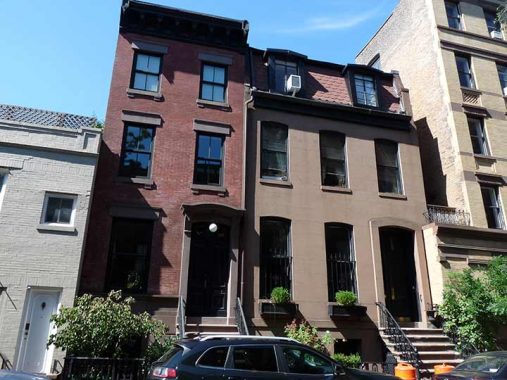
#256 (built 1877) and 258 West 4th (built 1866).

The building on the NW corner of Charles and West 4th Streets is the former #1 Van Nest Place, now #51 Charles. It was constructed in 1867 for Commissioner of Emigration George Starr. There were two identical rowhouses adjacent to it, #53 and #55, that were rented by Starr, who lived in #51. In 1917, the original #53 Charles was razed for the Congregation Darech Amuno synagogue.
Yet another amazing corner building, this one at the SW corner of Charles and West 4th, #62 Charles Street, built in 1828 by Samuel Whittemore with a 3-story height; the fourth was added later on, in 1898. #62 is the longtime home (since 1941) of the Spanish restaurant Sevilla — the restaurant’s website has a lengthy history of the establishment and also the general West Village area it inhabits.
There are a couple of infrastructural items to talk about here. The Village is home to many retro versions of the Bishop Crook lamppost. However Spring City, which makes a lot of these reproductions, missed the boat on one aspect–if it was indeed the longtime Pennsylvania manufacturer that created them. Notice the J-shaped pipe that holds the old fire alarm light indicator. Old-time castiron NYC poles had their own dedicated sconce styled to hold these lights, whose reflectors were originally globular in shape. Today only a few examples survive, on a special Type 6 lamp on Warren Street downtown and also on the Type G Corvingtons in Stuyvesant Town. The classic sconces couldn’t have been that tough to copy!
The other item is of course this Type 6 BC base, all that survives of a complete post that came down decades ago. Complete versions can be seen on this FNY page. They were bishop crooks, but with different bases and iron scrollwork. They were generally thinner, with narrower bases, and were designed for use on narrower sidewalks and streets. The Sevilla ownership had been using it as a planter for some time but they have now added a lamp. I’ll have to see what t looks like when lit at night. When I first found it, it was listing at almost a 45-degree angle but has been thankfully righted.
I had never been inside Fedora, on West 4th northwest of West 10th, but have been aware of it for many years because of its iconic neon sign, which lights up at night (“bar” in red, “Fedora” in green). I was unaware, all those years, that it wasn’t named for the hat, but for its now-former owner, Fedora Dorato, who had run the small basement Italian restaurant/tavern for sixty years.
Fedora Dorato came with her family from Florence in 1931 when she was 10. She has lived upstairs from the restaurant named for her since she married Henry Dorato in a building that Henry’s father bought in 1921, where he ran the restaurant speakeasy Charlie’s Garden. Except for paint jobs and air conditioning, the place has remained the same, with its pressed-metal ceiling, intimate tables and dedicated waiters. The Villager
Restaurateur Gabriel Stulman took over the space and “reimagined” it as “a casual supper club” according to Grub Street. Fedora spoke in favor of Stulman’s plan to the community board, which approved. She passed away in 2011. In 2020, the Covid Pandemic put an end to Fedrora for good. For now, the sign remains. Its building was built in 1839.
This 5-story apartment house, The Warwick, was built in 1881. Affixed to the West 10th Street side is a “humpback” street sign, used in NYC streets from the 1910s-1960s. As stated, the improbable meeting of West 4th and 10th Streets was created when the city decided to number both streets, which previously carried names.

There’s a little triangle of territory formed by 7th Avenue South, West 4th Street and West 10th Street and in it we have these two townhouses, #229 and 231–once part of a much lengthier row. 7th Avenue South is relatively new…just over a century old. It was built atop the IRT subway when it was extended south from Times Square downtown in the 1910s. It runs athwart the street grid, creating some unusual intersections and plots. These homes were built in 1873 and replaced the mansion of Senator Mark Spencer: West 4th Street on this block was once called Spencer Place.
For me there’s an aura of mystery about 228 West 4th between 7th Avenue S outhand West 10th, a romasque revival apartment house built in 1899. There’s those two sculptures in a classical style by the entrance, but who do they represent? The unusually named “gastropub” Wilfie & Nell occupies the ground floor: I can’t find the derivation of that name on any reviews.
This corner Art Moderne building with its terra cotta cladding is one of my favorite buildings in the Village, where West 4th meets the NW corner of Christopher. I don’t know, or have forgotten, the original purpose of this 1931 Art Deco classic and its friezes on the NW corner of 7AS and Christopher Street. The friezes show a sword-wielding soldier on horseback, which may provide a clue. It’s another parallellogram that faces on three separate streets.
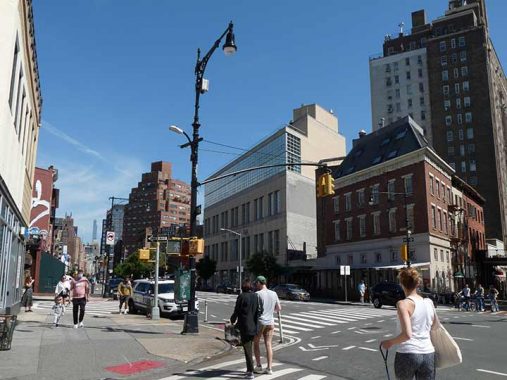
A word about the Corvington lamp/stoplight combo on the corner of 7AS and Christopher. A hallmark of the NYC Department of Transportation the past 30 years has been to mix and match. Before 1990 or so, it was unheard of, or maybe impossible, to take a massive guy-wired stoplight stanchion and affix a Corvington lamppost to the shaft, or attach a small cobra-neck lamp to illuminate the subway entrance. But such hybrids have become routine during that time.
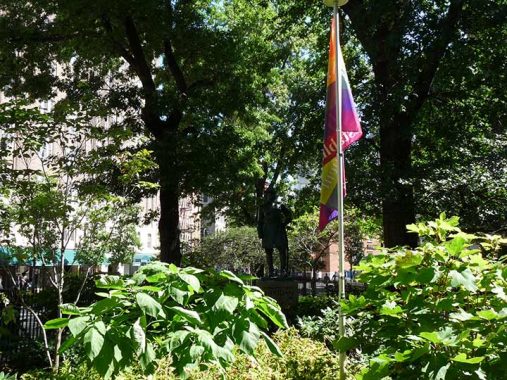
General Philip Sheridan has now taken a back seat in the “square” named for him in 1996.
7th Avenue South was created in 1912 by the extension of the original IRT subway through Manhattan’s lower west side from Greenwich Avenue south to what had been the junction of Varick, Clarkson and Carmine Streets, while 6th Avenue (which wasn’t given the suffix “South”) was rammed south from Carmine and Minetta Streets to Franklin and Church Streets in 1928 when the new Independent Subway needed a right-of-way. Both of these street map alterations required the condemnation and demolition of countless properties, and the alterations of almost as many.
Running 7th Avenue through the Village helped create one of New York City’s most complicated intersections., but it was complex enough to begin with. Christopher and Grove meet at a sharp angle, while West 4th comes in at an angle and meets Washington Place, creating a large area with two large triangles and a smaller one formed by Grove, 7AS and West 4th.

The heroic statue depicting General Philip Henry Sheridan, by sculptor Joseph Pollia, was installed in 1936.
Sheridan’s statue…is so poorly executed one might not know the subject without his name on the plinth. The sculptor was one of those whom [Hillaire] Belloc observed, “We dream in fire and work in clay, and some of us puddle in butter with our toes.”–William Bryk, New York Press, August 16-22, 2000
General Philip Sheridan is regarded as the most dynamic and popular officer of the Union Army during the Civil War. In the summer of 1864, Sheridan oversaw the ruthless destruction of the Shenandoah Valley, eliminating the Confederate army’s major source of food and supplies. That fall, General Sheridan rode more than twenty miles to rally his troops to victory after a surprise enemy attack.
After the war Sheridan fought in the Indian Wars in the Plains territories and was known for his harsh measures against Native Americans and brutal elimination of millions of buffalo. Sheridan denied uttering the phrase “The only good Indians I ever saw were dead” or its variant, “The only good Indian is a dead Indian.” The phrase was, though, paraphrased in Beneath the Planet of the Apes.
The square was named in honor of Sheridan in 1896 and was a concrete traffic island, with the statue, for most of its existence. It wasn’t until 1982 that the local Sheridan Square Triangle Association successfully petitioned the Parks Department to excavate the site and install plantings. Native American artifacts were discovered during the digging.
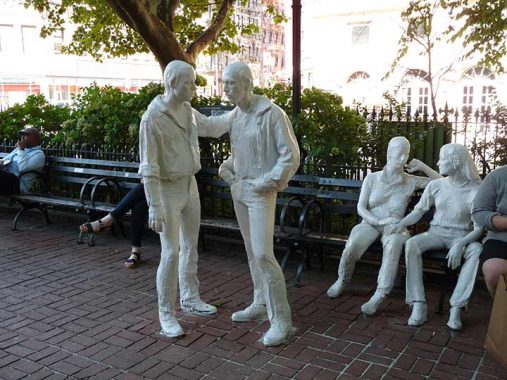

General Sheridan now takes a back seat, as I’ve said, to other monuments in the triangle. The Gay Liberation Monument, by sculptor George Segal, commemorates the uprising that took place in June 1969 to a police raid on the Stonewall Inn, on Christopher facing the triangle. The work was installed in 1992 after ten years of bureaucratic delays and some political opposition as well. Stonewall Inn itself was declared a national historic landmark in 2000.
Marsha Johnson (1945-1992) was a transgender activist and a familiar figure in the West Village, and co-founded (with Sylvia Rivera) the group STAR (Street Transvestite Action Revolutionaries), which offered housing to homeless and transgender youth. Johnson is also remembered by Marsha P. Johnson State Park, along the East River between North 7th and 10th Streets in Williamsburg.
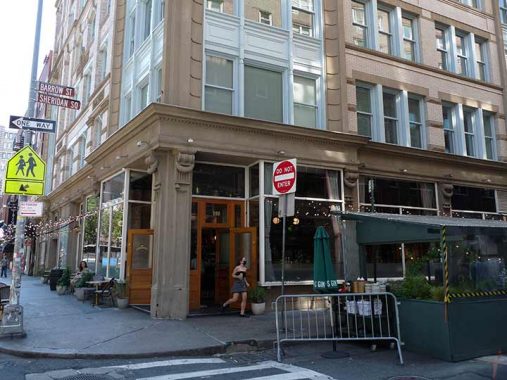
I spent a great deal of time on the corner of Barrow and West 4th in the 1980s in my postcollege era, when what is now The Spaniard was Jimmy Day’s. It’s located in a 9-story loft building with a terra cotta plaque, Hallanan Building, so named for the original owner of the site, Michael Hallanan’s horseshoeing business; according to legend, it was Hallanan’s idea to name this intersection Sheridan Square.
The Silversmith is at an address so narrow it gets a fraction, #184 3/4. The late Ruth Kuzub owned and operated the shop since 1960, offering her own handmade jewelry designs.
You might walk right by this unique stall-like shop if you didn’t know it was there, but her small display of broaches, rings, necklaces and amulets help draw the careful observer in. Some have known her for decades and stop by to thank her for the wedding ring she fashioned many years ago. Others thank her just because she is still there, an important link to the history of the neighborhood. [Village Preservation]
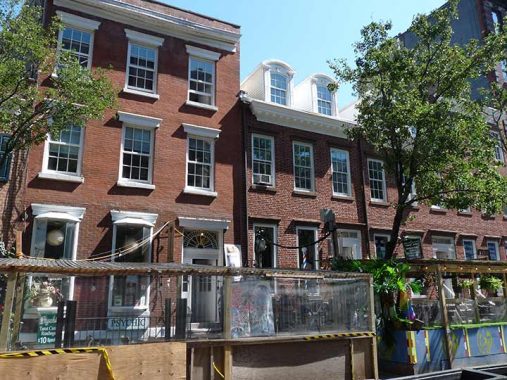
Here’s a group of Federal style attached homes at #175-179 West 4th, built in 1833, some with the dormer windows popular in the era. They were built by butchers who razed their slaughterhouses and constructed their homes here.
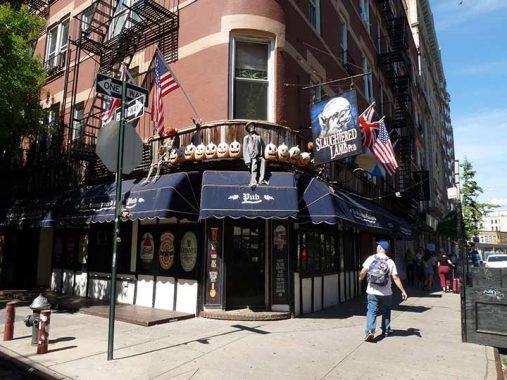
Speaking of slaughterhouses, here’s The Slaughtered Lamb, on the SW corner of West 4th and Jones. This does its briskest business of the year on October 31, when the famed Greenwich Village Halloween Parade is held. It was named for the pub of the same name in London, where a werewolf’s bite in “An American Werewolf in London” changed David Naughton for the worse.
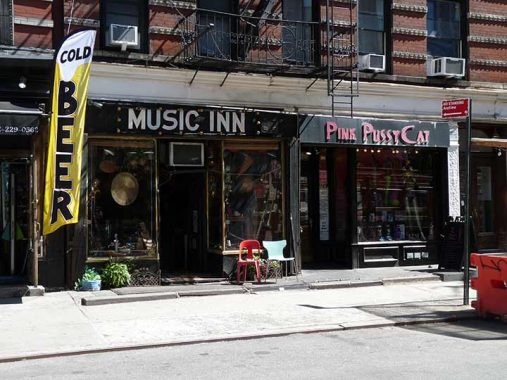
A pair of Village mainstays, Music Inn, at #169 West 4th, jam packed with everything playable imaginable, and hundreds of LPs on offer to boot, in business since 1958:
The shop has three main areas of instruments — wind, percussion and string — and they carry over 1000 kinds in the tightly packed shop with a basement level. If you can name it, they most likely have it. They also sell strings, accessories, and drum heads for a wide variety of instruments. [Village Preservation]
The longtime Village erotica clothing and paraphernalia purveyor, Pink Pussycat, in business since 1972, is next door at #167.
You can get anything you want in the Village.
Coming soon: West 4th from 6th Avenue east.
As always, “comment…as you see fit.” I earn a small payment when you click on any ad on the site.
10/17/21




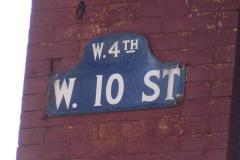
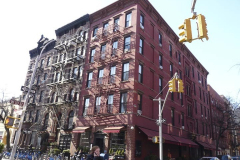

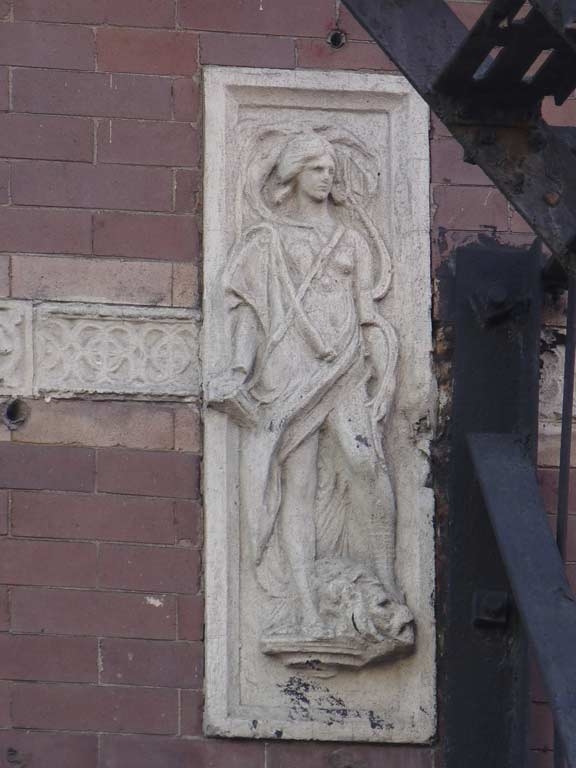
7 comments
Actually 10 St is the only numbered street south of 14 St to go from river to river (FDR to West St/West Side Highway), the only other numbered St to intersect the FDR is E 6 St which doesn’t serve the west side, and E 12 St. starts/ends at Ave D and 11 St interupts at Broadway and also ends at Ave D
Did Al “Grandpa” Lewis own, or at least manage, The Slaughtered Lamb? Thanks.
Al Lewis owned (or at least co-owned) a Bleecker Street restaurant called Grampa’s during the late 80s. It was open for only a few years, but every time I visted with my then-girlfriend — a hardcore Munsters fan — Al was holding down the fort. Nice man. Very friendly and outgoing. He’d give us desserts “on the house because the two of you are so good looking” (although to be honest, the food was dismal).
Great post. Positively 4th Street wasn’t included in Highway 61 Revisited.
Anyone remember the Tiffany Diner inside that Art Moderne building at West 4th and Christopher that’s now a Bank of America? Had many a greasy cheeseburger in that joint in the early 1990s.
I lived at 2 Horatio when I was a child. Corner Bistro was a go-to with my mom 1966. Thanks for the pictures.
Loved all of this info. Brought back memories of the 70’s on West 4th Many pitchers of Sangria at The Riviera Cafe, breakfasts and late night burgers at The Tiffany Diner . . . and watching the guys come and go from The Sheridan Square Gym atop the Tiffany . . .